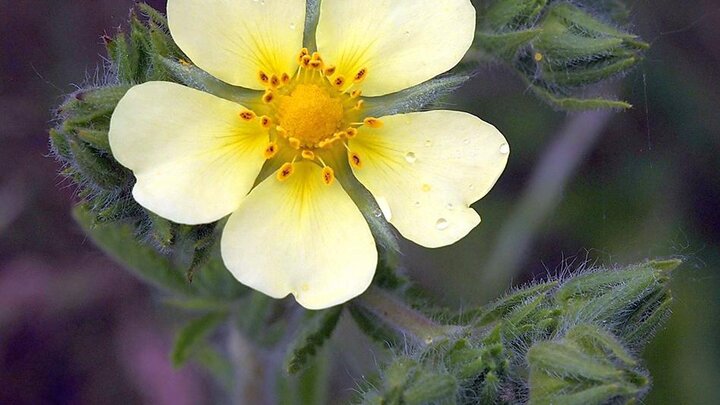This is one in a series of articles on current or potential invasive species to Nebraska. Early Detection and Rapid Response (EDRR) is a strategy to identify potential invasive species prior to or just as the establishment of the invasive is taking place. An integrated pest management plan (IPM) can be developed to manage, contain and eradicate the invasive species before it can spread further. This will avoid costly, long-term control efforts.
Sulphur Cinquefoil
Sulphur cinquefoil is a perennial forb identified in parts of Nebraska. It is either a state or local noxious weed in Colorado, Wyoming and other western states.
- Also known as rough-fruit cinquefoil, five-finger cinquefoil, and erect cinquefoil
- Also spelled as "sulfur cinquefoil"
- Scientific name: Potentilla recta L.
- Family: Rosaceae (Rose family)
- Origin: Europe, Eastern Mediterranean
Description
Figure 2. Sulphur cinquefoil
Sulphur cinquefoil was first reported in North America in the early 1900s and is now found across the United States and Canada.
Sulphur cinquefoil is an herbaceous perennial forb. A prolific seed producer, it reproduces/spreads primarily from seed. Seeds can remain viable in the soil for more than four years and mature plants can live for 20 years or more. One of the first plants to green up in the spring, it can remain green into the fall if adequate moisture is available.
Sulphur cinquefoil has a taproot, which dies back after a freeze. Regrowth from the roots may produce serval erect stems 0.3 to 0.9 meters (1 to 3 feet) tall. Leaves are composed of five- to seven-toothed leaflets that radiate from a common point. Long stiff hairs extend outward from the stems at right angles. Flowers are pale yellow/sulfur-colored with five heart-shaped petals produced at the end of the stems in June and July. Each flower produces hundreds of seeds, which can be scattered by water, wind, animals, and hay.
Habitat
Sulphur cinquefoil can be found in any type of habitat, but normally establishes quickly in disturbed areas and over-grazed sites. It can also invade healthy, undisturbed sites, out-competing desirable forbs and grasses in pastures and rangeland and reducing biodiversity. Sulphur cinquefoil is very aggressive and is known to out-compete even other invasive plants.
Sulphur cinquefoil has no forage value for livestock and contains high amounts of tannins, which can interfere with the digestive process. Wildlife have been observed to graze on the seed heads in the fall.
Management
Prevention is the best and cheapest management option. Having well-established grasses and forbs on a maintained pasture or rangeland with proper grazing and rotational grazing techniques can go a long way to prevent its establishment. Scouting, monitoring, and proper identification are key factors for management. Infestations can develop very rapidly.
Because sulphur cinquefoil is related to strawberries and a number of native cinquefoils, there are no biological control methods other than grazing with sheep or goats to reduce seed production and seed viability. Pulling and/or digging up the plants below the crown is effective if there are a few plants. Mowing is not a viable option.
Numerous chemical treatments are available to manage sulphur cinquefoil. Be sure to select a product labeled for the site. Products containing aminopyralid, clopyralid, chlorsulfuron, dicamba, metsulfuron, picloram, triclopyr, glyphosate (non-selective) and 2,4-D have been shown to work. 2,4-D will only suppress plant growth. Products with residual may do better. Spring or fall applications, especially in the rosette stage prior to the pre-bud stage, are best. Adding a non-ionic surfactant to the herbicide mix will aid control. Retreatment is usually necessary in three to five years. Read, understand and follow all label instructions when using any pesticide. Confirm the identification of sulphur cinquefoil before herbicide application to avoid treating native cinquefoil species.
References
Frost, R., “Featured Weed: Sulfur Cinquefoil,” Big Sky Small Acres, Montana State University, Winter 2010
Kadrmas, T. et al, “Identifying and Managing Sulfur Cinquefoil,” University of Nevada, Fact Sheet 03-04
“Sulfur Cinquefoil,” Washington State University, Island County Noxious Weed Program Weed Alert
USDA / NRCS Plant Profile, “Sulfur Cinquefoil, Potentilla recta L.”




